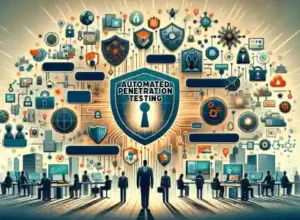
Discover the essentials of automated penetration testing and its role in enhancing cyber security strategies with Rootshell Security.
In light of the increasing sophistication of cyber threats, the significance of adopting advanced security measures cannot be overstated.
Automated penetration testing, in particular, offers an invaluable solution, enabling organizations to identify vulnerabilities with unprecedented speed and efficiency, thus fortifying their defenses in the relentless battle against cyber incursions.
Cyber Vulnerabilities: A Growing Concern
In 2023, DarkBeam, a digital protection firm, had a data breach that led to the leak of more than 3.8 billion records. In January of the same year, Twitter (now known as X) had over 220 million email addresses stolen.
These aren’t isolated incidents. In 2023, 32% of small UK businesses reported cyber attacks or data breaches. The numbers were higher (59% and 69% respectively) for medium and large businesses.
With the increase in cyber threats, organisations worldwide are worried about ensuring their digital systems are strong and secure. To do so, they require stringent cyber security measures.
One of these measures is penetration testing.
What is Automated Penetration Testing?
Automated penetration testing is also known as vulnerability scanning. It is an advanced cyber security process adopted by many organisations. This security assessment method leverages tools to quickly identify security vulnerabilities within systems and applications.
Automated pentesting is when you use AI-powered scanning tools to look for vulnerabilities. It brings several perks to the table. Some of the remarkable benefits are speed, scalability, cost-effectiveness, and an opportunity for continuous security testing.
This means that you don’t need to wait for a dedicated professional to manually test and identify security flaws in web applications. Your organisation can use AI-driven security testing including web application penetration tools, to recognise known security flaws at a much faster pace.
With continuous scanning capabilities, the software tools can provide year-round scanning. That eventually leads to thorough and frequent tests. You can’t get this level of continuity of security with manual tests conducted by human ethical hackers.
Also, the cost-effectiveness of using automation tools is quite apparent. They significantly reduce reliance on expertise. That helps you cut down on staffing costs.
Let’s explore the benefits that automated pentesting provides in a bit more detail.
Benefits of Automated Penetration Testing
Digital disruption is no longer a term from the future; companies today are embracing digital elements at a breakneck speed. With this broader digital landscape comes broader potential threats that organisations are exposed to. Penetration testing, supported by the expertise of security professionals, plays a crucial role in mitigating them.
Speed and Scalability
One of the most significant advantages of automation-based penetration testing tools is that they are remarkably fast and scalable. The tools are not restricted to the pace and limitations of human testers. They can scan the entire network much faster than a manual pen tester. As a result, they can perform hundreds of tests simultaneously and provide instant feedback.
Comprehensive Reports
These pentesting tools are known for their ability to generate detailed reports. These reports identify vulnerabilities and also rank them based on their severity. In essence, they give you a risk profile of the system.
Such comprehensive insights are incredibly valuable for web development teams when remediating vulnerabilities or planning security enhancements.
Maintain Continuity of Security
Automated penetration testing services offer a constant shield of security, thanks to their ongoing scanning capabilities. This means your systems can be tested for the OWASP Top 10 vulnerabilities and more, as often as needed.
That is essential in an environment where new types of vulnerabilities could be discovered at any moment. You won’t get that with standard testing.
Reduced Dependence on Human Expertise
Manual penetration testing requires a highly skilled and certified security professional. You don’t need the same expertise for automated pentesting. A trusted automated pen testing tool can scan and evaluate possible vulnerabilities without continual human intervention.
That is not to say human experts aren’t needed at all. They are. However, these tools give them the liberty to concentrate on areas demanding their expertise, while the repetitive scanning and reporting tasks can be assigned to AI-driven tools.
Despite these significant advantages, such penetration testing methods come with limitations. It’s important to recognize the potential drawbacks when incorporating this type of testing into your security measures.
Why is it important to continuously conduct penetration testing for a strong security system?
Continuous penetration testing is crucial because it helps identify and mitigate new vulnerabilities as they arise, keeping the system secure against evolving threats. Regular testing ensures that security measures are up-to-date and effective, maintaining robust protection for sensitive data.
Automated Penetration Testing Limitations
Whilst the advantages of automated penetration testing are impressive, it’s equally essential to acknowledge its limitations. You can’t rely completely on an testing approach. If you do, you risk not being able to identify complex vulnerabilities. You will then fail at adequately protecting systems against potential threat actors.
Here are some reasons why you can’t leave it all to automated testing.
Lack of Context Understanding
Automated pen testing tools are brilliant at identifying known vulnerabilities. However, they often lack the contextual understanding of a human tester.
Cyber threat actors do not follow a script, and their actions can be unpredictable. Humans excel in understanding these complex contexts. An automated tool, on the other hand, could overlook novel or complex vulnerabilities.
Difficulty in Simulating Complex Attacks
Advanced threat actors often use complex multi-step attacks. penetration testing software finds it challenging to replicate them.
Similarly, social engineering attacks rely on human interaction or deception. Automated tools are often unable to replicate these as well.
False Positives and False Negatives
A common limitation commonly linked with automation tools is the generation of false positives and false negatives. A false positive will identify a security vulnerability where there isn’t one. A false negative, on the other hand, might ignore a potential issue.
The latter is potentially more damaging. You risk overlooking a genuine security concern. However, both situations can lead to wasted time and resources.
Generalised Feedback for Automated Penetration Testing
Software tools often provide generalised feedback based on predefined sets of vulnerabilities to look for. They struggle to analyse more sophisticated issues that a human expert, with their lateral thinking, could easily detect. This surface-level analysis may leave undiscovered vulnerabilities ripe for exploitation by cyber attackers.

Who Needs Automated Penetration Testing?
Automated penetration testing is not just for large corporations with vast digital landscapes. Small and medium-sized enterprises (SMEs), government agencies, healthcare organisations, and educational institutions also benefit greatly from it.
Essentially, any organisation that holds sensitive data needs to ensure its digital defences are impenetrable. This data can be customer information, intellectual property, or financial records.
It also provides an accessible starting point for organisations to assess their security posture regularly.
Manual vs Automated Penetration Testing
Whilst both methods aim to strengthen cyber defences, they serve different purposes and complement each other. Manual penetration testing is indispensable for a deep, nuanced understanding of complex vulnerabilities. It also helps simulate sophisticated cyber-attack scenarios that these tools might miss. This approach serves as an essential entry point for deeper and more nuanced assessment, especially in areas where automation tools fall short.
On the other hand, automated penetration testing excels in covering broad digital landscapes quickly. It helps identify known vulnerabilities across numerous systems. It also provides continuous security assessments.
The optimal approach for most organisations is a blend of both. That way, you leverage the speed and efficiency of these tools. At the same time, you have human experts for their critical thinking and creative problem-solving abilities.
Checks Performed by Automated Penetration Testing
Automated penetration testing can perform a wide array of checks, including but not limited to:
- Vulnerability Scanning: Identifying known vulnerabilities in software and applications.
- Configuration Audits: Checking systems against security best practices to find misconfiguration.
- Web Application Scanning: Detecting common vulnerabilities like SQL injection, cross-site scripting (XSS), and other OWASP Top 10 risks.
- Network Scanning: Mapping out the network to identify open ports and associated services that could be vulnerable.
- Credential Testing: Assessing the strength of passwords and finding default or weak credentials that could be easily exploited.
Can Automated Pentesting Replace Human Expertise?
Automation is an invaluable open-source tool in the cybersecurity arsenal for identifying potential vulnerabilities. However, it cannot replace the nuanced understanding and adaptability of human expertise.
These tools provide breadth and efficiency. But, they cannot think creatively, understand complex contexts, and anticipate unconventional threat actor behaviours.
You need human experts to interpret testing results, conduct in-depth analyses, and craft strategic responses to sophisticated cyber threats.

Combining Automated and Manual Testing
As you can see, automated security should be a part of your cyber security toolkit. However, you do need to mitigate the limitations associated with it, recognizing that testing cannot solely rely on automated processes.
To address these challenges, you need to combine automated vulnerability detection with manual pentesting conducted by human ethical hackers. Human pen testers offer creativity, adaptability, and critical thinking abilities. They can provide a more comprehensive and context-aware assessment than programmed tools alone, highlighting the critical role of manual and automated penetration in a robust cybersecurity strategy.
Whilst pentesting this way is efficient for regular updates and automated scans, you should schedule manual penetration periodically.
Humans have a critical understanding of business logic. They can simulate real-life attack scenarios, and execute targeted and sophisticated attacks.
This combination can be highly effective when paired with AI-driven vulnerability scanning.
Here are some of the benefits of this combined approach.
Deeper and More Nuanced Assessment
Manual tests brings in-depth security analysis to the table. It provides detailed insights into potential threats and vulnerabilities. This testing can find dangerous bugs in your digital system that could be exploited.
Refining the Automated Tools
Manual penetration testers or ‘bug bounty hunters’ can help refine and focus automation tools by contextualising and interpreting the findings. This can help your testing software achieve results that are focused on your business’s needs. With such refined findings, you can bolster your cyber security.
Identifying Complex Vulnerabilities
Tools offering continuous and instant vulnerability detection complement manual pen tests, which provide intuition and lateral thinking. By merging these two approaches, you can effectively identify both simple and complex vulnerabilities.
Discover Rootshell Security’s Advanced Automated Penetration Testing
Rootshell Security combines cutting-edge automated penetration testing services with expert insights, transforming cyber security management with our AI-powered platform. Our RedForce team, a dedicated red team, delivers offensive security assessments, including a comprehensive pentest, fortified by continuous vulnerability scanners and the use of automated scanners. These measures are designed to protect against complex cyber threats, ensuring that your security team is equipped with advanced security tools and automation to detect and address security weaknesses efficiently.
This comprehensive approach not only prioritizes actionable insights, streamlines remediation, and enhances your digital defenses but also aligns with the latest testing policy and adapts to emerging threats through an updated vulnerability database and robust security controls.
Elevate Your Cyber Security With Rootshell
Secure your digital assets with Rootshell Security. Learn more about how we can help protect your business from cyber-attacks.
Subscribe So You Never Miss an Update



